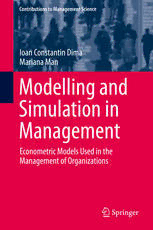Table Of ContentContributions to Management Science
Ioan Constantin Dima
Mariana Man
Modelling and
Simulation in
Management
Econometric Models Used in the
Management of Organizations
Contributions to Management Science
More information about this series at
http://www.springer.com/series/1505
Ioan Constantin Dima • Mariana Man
Modelling and Simulation
in Management
Econometric Models Used in the Management
of Organizations
IoanConstantinDima MarianaMan
“Valahia”UniversityofTargoviste UniversityofPetrosani
Dambovita Petrosani
Romania Hunedoara
Romania
ISSN1431-1941 ISSN2197-716X (electronic)
ContributionstoManagementScience
ISBN978-3-319-16591-2 ISBN978-3-319-16592-9 (eBook)
DOI10.1007/978-3-319-16592-9
LibraryofCongressControlNumber:2015938760
SpringerChamHeidelbergNewYorkDordrechtLondon
©SpringerInternationalPublishingSwitzerland2015
Thisworkissubjecttocopyright.AllrightsarereservedbythePublisher,whetherthewholeorpartof
the material is concerned, specifically the rights of translation, reprinting, reuse of illustrations,
recitation, broadcasting, reproduction on microfilms or in any other physical way, and transmission
or information storage and retrieval, electronic adaptation, computer software, or by similar or
dissimilarmethodologynowknownorhereafterdeveloped.
The use of general descriptive names, registered names, trademarks, service marks, etc. in this
publicationdoesnotimply,evenintheabsenceofaspecificstatement,thatsuchnamesareexempt
fromtherelevantprotectivelawsandregulationsandthereforefreeforgeneraluse.
Thepublisher,theauthorsandtheeditorsaresafetoassumethattheadviceandinformationinthis
book are believed to be true and accurate at the date of publication. Neither the publisher nor the
authors or the editors give a warranty, express or implied, with respect to the material contained
hereinorforanyerrorsoromissionsthatmayhavebeenmade.
Printedonacid-freepaper
Springer International Publishing AG Switzerland is part of Springer Science+Business Media
(www.springer.com)
Neverregardstudyasdutybutasanenviable
opportunitytolearntoknowtheliberating
influenceofbeautyintherealmofthespiritfor
yourownpersonaljoyandtotheprofitofthe
communitytowhichyourlaterworkbelongs.
AlbertEinstein
ThiSisaFMBlankPage
Foreword
Theglobalisationwefacenowadaysderivesfromthefactthat,bystartingfromthe
technological and economical development, a significant number of human activ-
ities are situated on such a large scale and scope that they exceed the national
borderswithinthelimitsofwhichthesovereignstatesexercisetheirrighttogovern.
The enhancement of current globalisation represents the fundamental feature of
worldeconomyatthebeginningofthetwenty-firstcenturyandischaracterisedby
emphasising the trend to reduce and remove the barriers between the national
economiesandenhancingtheconnectionsbetweentheseeconomies.
The diversity and flexibility, the ability to adapt and respond to changes in the
environmentandthefocusoncustomerneedssatisfactionarekeycategoriesinthe
futuremanagement.Rapidlychangingbusinessenvironmentintheeconomic,social
andtechnologicalareasposesnewchallengesforthecreationofeffectivemanage-
ment tools. Because of the complexity and volume of information and knowledge
affecting the organisation functioning, contemporary organisations operate ineffi-
cientlybecauseoftheold,rigidandhierarchicaldecision-makingsystem. Compa-
niesoperatinginsuchadynamicenvironmentarelookingformanagementmodels
basedontheknowledgethatallowsthemforintensiveutilisationofthedevelopment
of science, technology, organisation and management and the whole range of
specificskillsanddynamicallydevelopingcompetence.
Thecurrentmanagementmodelsinsufficientlyapplytheknowledgeandskillsof
employeesandtheirundoubtedadvantagesasawillingnesstocreatenewsolutions,
taking initiative and responsibility, which can in effect create a competitive
advantage.
Moreover,itiswell-knownmaxim“Youcan’tmanagewhatyoudon’tmeasure.
It is an old management adage that is accurate today. Unless you measure some-
thing you don’t know if it is getting better or worse. You can’t manage for
improvement if you don’t measure to see what is getting better and what isn’t.”
Inthiscontext,theconsiderationincludedbyI.C.Dimainthebook“Econometric
ModelsUsedintheManagementofOrganisationalEntities”basedoneconometrics
vii
viii Foreword
methods’ usage seems to be very useful for business practice and important for
knowledgedevelopment.
Theimportanceofasystemicapproachinamarketeconomy,whichisthebasis
of the solutions proposed by the authors in this book, is the result of rapidly
increasing flow of material and information flows. International cooperation has
been expanded, which increases the corporate links that directly impact on enter-
prise systems. New relationships within the organisation are formed and new
generationsofsystemsolutionsalsocreatedcausesthatrequireathoroughknowl-
edge of the functioning of the solutions and mechanisms for the development of
managementsystemsofeconomicorganisation.Today,theneedofreevaluationof
currentmethodsofmanagement andsearchforsolutionsbasedonreal economet-
rics foundations is clear. In this context, the consideration proposed by authors is
perfectandreadyforintroduction.
This book is recommended to the reader by dealing with three research sub-
themesinaunitaryconcept,whicharetogethertheresearchachievedbypublishing
this book. It is a matter of organisational entities dealt with in terms of systems
theory,theoreticalaspectsoftheeconometricresearchandallthemodelsusedby
econometricstostudytheorganisationalmanagement.
Inthefirstresearchsub-theme,consideringthatthegeneraltheoryofsystems—
cybernetics—andthecurrentstageofthescientificresearchenabletheirapproach
at a more systematic scientific level, this book highlights some aspects of the
genesis and development of hierarchical systems related to the hierarchy of the
movement forms, matter and society, as well as that of the level of organisation.
Theevolutionofthenaturalsystems,ingeneral,alongwiththephysical,chemical,
economic,politicalandmanagerialphenomena,presentsunitarycyberneticaspects
based on admitting the adjustments and associating the structures with invariants.
Studyingtheseaspects,thebookintroducestrans-disciplinaryprinciplesofepiste-
mologicallevel, which providean axiomatisingbasistoelaboratethe genesisand
developmentofsystemsonallorganisational levels.Inthisrespect,thefollowing
area dealt with elements of systems theory, theory of organisations and
organisationalentitiesintheglobalisedmarketeconomy.
Thesecondresearchsub-themedealswitheconometricsasbeingthatbranchof
economicscienceswhichstudiestherelationsbetweentheeconomicvariables,as
they appear postulated in an abstract model. It is operated with the distinction
between econometrics broadly—which does not limit a priori the scope of usable
methodsandmodelsandmakesuseofallstructuralandquantitativetechniques—
and econometrics narrowly—which limits a priori this scope to all the statistical
methods and therefore appears as a set of applications of statistics in economic
modelling.Theconnectionbetweenvariablesisobviousinbothcases,throughan
abstract model of econometric relations. In essence, notions of model, object,
relation,function,simulation,modelling,trend,input–output,etc.,areaccessed.
The last part ofthe book—through the third research sub-theme—provides the
reader with elements of econometric modelling, which currently and frequently
make use of the probabilistic mathematics and random analysis. The refusal to
accept the uncertainty at the model level normally results in the difficulty to
Foreword ix
introduce the design of the evolution of economic processes into analysis, if one
doesnottakeintoaccounttheinformation,withoutwhichtheuncertaintycannotbe
studied.Therefore,theabstractmodelineconometricsisasupportandareference
point of reasoning in general and in particular a generator of a certain conceptua-
lisation of the central idea of connection between the variables describing the
evolution within the system. The book presents econometric models focused
particularly on the functions of organisational entities, but not only. I also give
specialinteresttomodellingtheproductionquality,modellingthecosts,modelling
theinnovativeactivity,etc.
When addressing the complex issues dealt with in the book, the authors enter
into dialogue with the opinions presented by a rich classical and contemporary
bibliography,aswellaswiththeopinionspresentedinthecommunicationsdeliv-
ered at international scientific conferences and with those existing in the papers
publishedinjournalswithahighscientificimpact.Thisstudyistheresultofmany
years of author’s experience expanded through international collaboration with
researchersfromuniversitiesinmanycountriesandbusinessmanagementpractices
includinglargetransnationalcorporations.
This book is addressed to both theoreticians and practitioners in the field of
operative management of industrial production. This equally concerns those who
study—students, graduates and doctoral students, those who have experience in
this field—researchers and professors, as well as those who actually work in
production—engineers,technicians,economists,developers,logisticians,company
managers,presidentsoftheadministrativeboard,etc.
It was personally a great pleasure to collaborate with the authors and we are
pleasedthatthisbookisanimportantmilestoneforwardineconometricsmethods
introductioninmanagement.Wehopethatyoutoofeelthesameafterreadingthis
book, andwe are sure,it can be inspiring for discussion andmanagerial solutions
improvement.
Poland MariaNowicka-Skowron
September2014 JanuszK.Grabara
SebastianKot

